
The Worshipful Company of Grocers is one of the 111 livery companies of the City of London, ranking second in order of precedence.
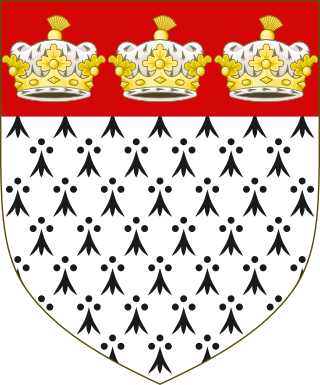
The Worshipful Company of Skinners is one of the Great Twelve Livery Companies of the City of London. Originally formed as an association of those engaged in the trade of skins and furs, the Company was granted a Royal Charter in 1327.

The Worshipful Company of Ironmongers is one of the Great Twelve livery companies of the City of London, incorporated under a Royal Charter in 1463.

The Worshipful Company of Clothworkers was incorporated by Royal Charter in 1528, formed by the amalgamation of its two predecessor companies, the Fullers and the Shearmen. It succeeded to the position of the Shearmen's Company and thus ranks twelfth in the order of precedence of Livery Companies of the City of London.

The Worshipful Company of Cutlers is one of the ancient Livery Companies of the City of London. It ranks 18th in the order of precedence of the Companies.

The Worshipful Company of Leathersellers is one of the livery companies of the City of London. The organisation originates from the latter part of the 14th century receiving its Royal Charter in 1444, and is therefore the senior leather industry-related City Livery Company.

The Worshipful Company of Cordwainers is one of the Livery Companies of the City of London. Cordwainers were workers in fine leather; the Company gets its name from "cordwain" (cordovan), the white leather produced from goatskin in Cordova, Spain. All fine leather makers, including Girdlers and Glovers, were originally classified as cordwainers; however, the term eventually came to refer only to fine leather footwear, including boots.

The Worshipful Company of Glovers is one of the ancient Livery Companies of the City of London. Glovers separated from the Cordwainers to form their own organisation in 1349 and received a Royal Charter of incorporation in 1639. The company is, as are most other Livery Companies, a charitable organisation, but it still retains close links to its original trade.
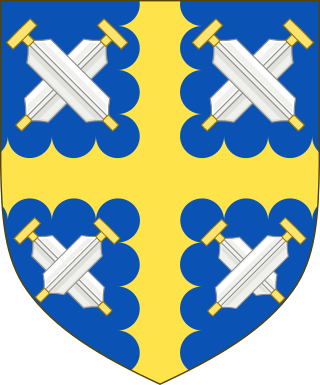
The Worshipful Company of Curriers is one of the ancient livery companies of London, associated with the leather trade.

The Worshipful Company of Masons is one of the ancient Livery Companies of the City of London, number 30 in the order of precedence of the 111 companies. It was granted Arms in 1472, during the reign of King Edward IV; its motto is “God Is Our Guide”.
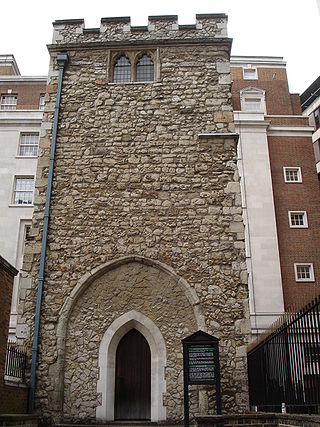
All Hallows Staining was a Church of England church located at the junction of Mark Lane and Dunster Court in the north-eastern corner of Langbourn ward in the City of London, England, close to Fenchurch Street railway station. All that remains of the church is the tower, built around AD 1320 as part of the second church on the site. Use of the grounds around the church is the subject of the Allhallows Staining Church Act 2010.

Long Acre is a street in the City of Westminster in central London. It runs from St Martin's Lane, at its western end, to Drury Lane in the east. The street was completed in the early 17th century and was once known for its coach-makers, and later for its car dealers.

Goldsmiths' Hall is a Grade I listed building at the junction of Foster Lane and Gresham Street in the City of London. It has served as an assay office and the headquarters of London's goldsmith guild, the Worshipful Company of Goldsmiths, one of the livery companies of the City of London. The company has been based at this location since 1339, the present building being their third hall on the site.

Coade stone or Lithodipyra or Lithodipra is stoneware that was often described as an artificial stone in the late 18th and early 19th centuries. It was used for moulding neoclassical statues, architectural decorations and garden ornaments of the highest quality that remain virtually weatherproof today.
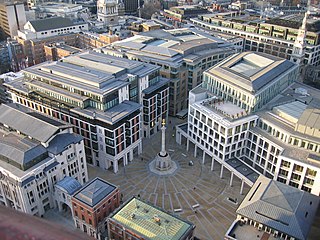
Bread Street is one of the 26 wards of the City of London, the name deriving from its principal street, which was anciently the city's bread market; already named Bredstrate for by the records it appears as that in 1302, Edward I announced that "the bakers of Bromley and Stratford-le-Bow [London], and ones already living on the street, were forbidden from selling bread from their own homes or bakeries, and could only do so from Bread Street." The street itself is just under 500 ft in length and now forms the eastern boundary of the ward after the 2003 boundary changes.
St Benet Sherehog, additionally dedicated to St Osyth, was a medieval parish church built before the year 1111, on a site now occupied by No 1 Poultry in Cordwainer Ward, in what was then the wool-dealing district of the City of London. A shere hog is a castrated ram after its first shearing.
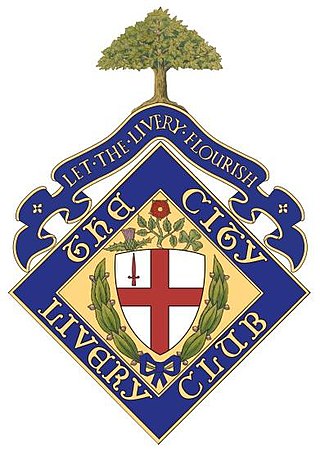
City Livery Club is a members-only club in the City of London, which was established in June 1914. It is based at Bell Wharf Lane, Upper Thames Street, London EC4R 3TB, in the City of London, a site that it shares with the Little Ship Club.

St Mary, Haggerston, was an Anglican parish church built to the designs of John Nash in 1827, in what is now the London Borough of Hackney. Built in the Gothic style of its time, it had an elaborate west front with a disproportionately tall tower. The rest of the church was, in comparison, rather plain. It was altered later in the 19th century by James Brooks as the first initiative of the Haggerston Church Scheme, and destroyed by bombs during the Second World War. The site is now a children's playground west of Haggerston Park, between Thurtle Road and Queensbridge Road.

Mare Street is a street in the London Borough of Hackney. It has existed since the 15th century, when it was one of the first roads at the centre of the parish. It was then known as Merestret. The word mere was either the Old English mǣre meaning a boundary — referring to the boundary with the parish of Stepney — or mere, a large pond which was fed by Hackney Brook.
The Broderers' Hall or Embroiderers' Hall at 36 Gutter Lane was the livery hall of the Worshipful Company of Broderers, the City of London livery company for embroiderers from 1515 until its destruction in 1940.


















